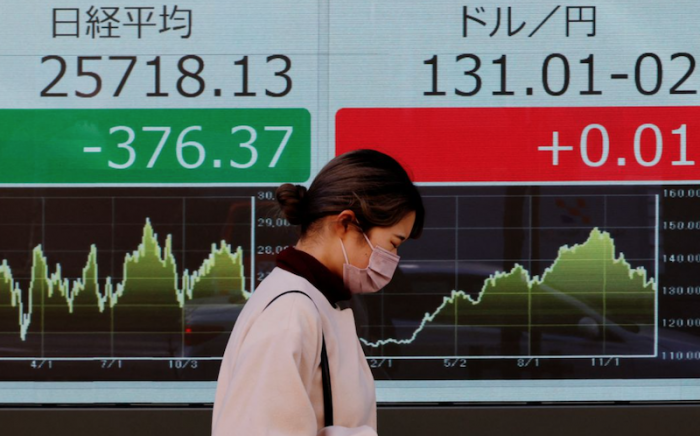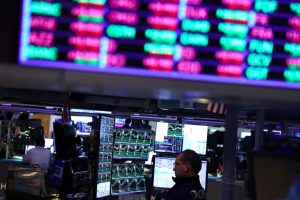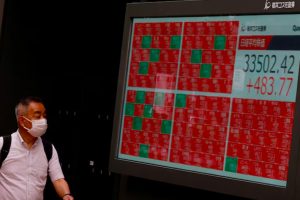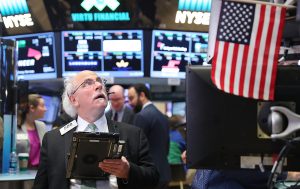Stock markets plunged across Asia on Monday – in a torrent of selling that triggered circuit breakers across the region.
The Nikkei in Japan plummeted by a whopping 12%, while Taiwanese and Korean shares both fell by over 8%.
Reasons for the plunge included fears that the United States and other economies could be heading toward recession if the Federal Reserve and other central banks continue to delay interest rate cuts, as well as increasing concern about the recent surge in tech stocks and a wider war in the Middle East.
ALSO SEE: China to Set Emission Quotas for Industries, Economic Planners
Investors put money into the safe haven yen and Swiss franc as crowded carry trades unravelled, sparking speculation some had to unload profitable trades just to get the money to cover losses elsewhere.
Nasdaq futures sank a deep 4.7%, while S&P 500 futures dropped 12.4% as the rout went worldwide. EUROSTOXX 50 futures fell 2.1% and FTSE futures 1.2%.
Japan’s Nikkei hit seven-month lows – a scale of losses not seen since the 2011 global financial crisis. MSCI’s broadest index of Asia-Pacific shares outside Japan lost 4.2%.
Losses by Chinese stocks were more moderate, aided by a bounce in the Caixin services PMI to 52.1. The Shanghai Composite was down 1.54% at 3pm, while the Hang Seng Index fell by a bigger margin before recovering to be 1.64% down near the close of trading.
There were also big losses in Mumbai, Bangkok, Manila, Jakarta and Wellington.
Japanese 10-year bond yields fell a steep 17 basis points to the lowest since April at 0.785%, as markets radically reconsidered the prospect of another hike from the Bank of Japan.
Of all the commentary on the day’s stock drama, remarks by the Royal Bank of Canada Wealth Management stood out.
RBC WM’s Global Insight Weekly said the Bank of Japan’s move last week to raise its benchmark interest rate to around 0.25% and its plan to halve its bond purchases by the first quarter of 2026, would eventually bare fruit because the beleaguered yen has turned the corner.
“Longer term, we believe the market will react positively to rate hikes resulting from the economy’s normalization. Our research correspondent firm believes the path of sustained ‘good’ rate hikes that the central bank announced on the July 31 will lead to a self-sustaining rise in Japan’s equity market,” it said.
Meanwhile, US Treasury bonds were in demand with 10-year yields hitting 3.723%, the lowest since mid-2023.
Two-year yields dropped to 3.807%, having already fallen 50 basis points last week, and could soon slide below 10-year yields, turning the curve positive in a way that has heralded recessions in the past.
Talk of bigger rate cuts by Fed
The worryingly weak July payrolls report saw markets price in a 78% chance the Federal Reserve will not only cut rates in September, but ease by a full 50 basis points. Futures imply 122 basis points of cuts in the 5.25-5.5% funds rate this year, and see rates around 3.0% by the end of 2025.
“We have increased our 12-month recession odds by 10pp to 25%,” analysts at Goldman Sachs said in a note, though they thought the danger was limited by the sheer scope the Fed had to ease policy.
Goldman now expects quarter-point cuts in September, November, and December.
“The premise of our forecast is that job growth will recover in August and the FOMC will judge 25bp cuts a sufficient response to any downside risks,” they added. “If we are wrong and the August employment report is as weak as the July report, then a 50bp cut would be likely in September.”
Analysts at JPMorgan were even more bearish, subscribing a 50% probability to a US recession.
“Now that the Fed looks to be materially behind the curve, we expect a 50bp cut at the September meeting, followed by another 50bp cut in November,” said economist Michael Feroli.
“Indeed, a case could be made for an inter-meeting easing, especially if the data soften further — although Fed officials might worry about how such a move could be (mis)interpreted.”
Yen rising, Euro dives
Investors will get a read on employment in the service sector from the ISM non-manufacturing survey due later Monday and analysts are hoping for a rebound to 51.0 after June’s unexpected slide to 48.8.
This week has earnings from industrial bellwether Caterpillar and media giant Walt Disney, which will give more insight into the state of the consumer and manufacturing. Also reporting are healthcare heavyweights such as weight-loss drugmaker Eli Lilly.
The huge drop in Treasury yields had also overshadowed the US dollar’s usual safe-haven appeal and dragged the currency down 0.4% on a basket of majors.
The dollar shed another 2.2% on the Japanese yen at 143.10, while the euro dived 1.9% to 156.35. The single currency was holding firm on the dollar at $1.0934.
The Swiss franc was a major beneficiary of the rush from risk, with the dollar falling 0.9% to touch six-month lows at 0.8485 francs.
“The shift in expected interest rate differentials against the US has outweighed the deterioration in risk sentiment,” Jonas Goltermann, deputy chief markets economist at Capital Economics, said.
“If the recession narrative takes hold in earnest, we would expect that to change, and the dollar to rebound as safe-haven demand becomes the dominant driver in currency markets.”
Investors had also increased wagers other major central banks would follow the Fed’s lead and ease more aggressively, with the European Central Bank now seen cutting by 67 basis points by Christmas.
In commodity markets, gold gained a safety bid and rose to $2,456 an ounce.
Oil prices started firmer amid concerns about a widening conflict in the Middle East, but worries about global demand soon dragged it down again.
Brent slipped 13 cents to $76.68 a barrel, while US crude lost 22 cents to $73.30 per barrel.
Bitcoin was down more than 14% to about $50,900 – just after 7am in London – while Ether suffered its steepest fall since 2021 to $2,286.
Key figures
Tokyo – Nikkei 225 < DOWN 12.40% at 31,458.42 (close)
Hong Kong – Hang Seng Index < DOWN 1.46% at 16,698.36 (close)
Shanghai – Composite < DOWN 1.54% at 2,860.70 (close)
London – FTSE 100 < DOWN 2.09% at 2.09% (0934 BST)
New York – Dow < DOWN 1.51% at 39,737.26 (Friday close)
- Reuters with additional inputs and editing by Jim Pollard and Sean O’Meara
NOTE: Further details were added to this report on August 5, 204.
ALSO SEE:
Bank of Japan in Rare Rate Rise, Bond Taper Plan Unveiled
China Says July Was Hottest Month Ever Recorded – VE
Global Corporate Outlook Hit by China’s Worsening Slowdown
China Faces Low Growth Without Greater Stimulus, Analysts Say
Hedge Funds Boost Japan Allocations, China Stocks at 5-Year Low
























